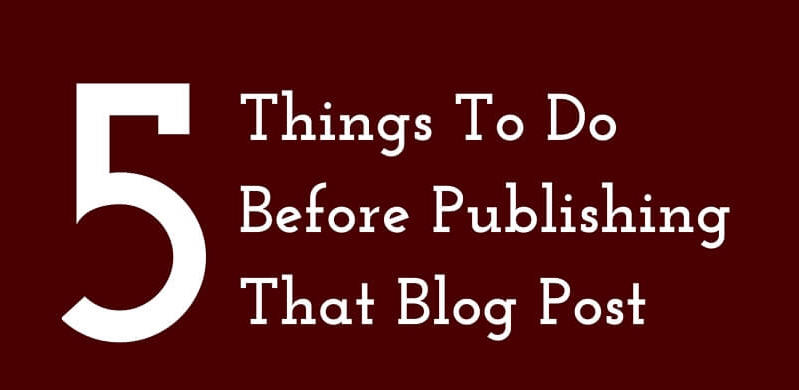4 Things to Consider Before Creating Multiple Blogs (Instead of Having Just One)

Your online presence is important, and many of us have created websites that serve as our eHomes and electronic resumes. Blogs count and although many of them have very focused niches and subject matters, others are more broad and cover a wide range of topics.
Some of us have multiple sites and others might even be debating whether they should have several, instead of one. Before you go creating a separate space to store your content, you should have a good reason to do it. Otherwise, you will run the risk of confusing people and weak strategy is the enemy of progress often.
As a blogger and content creator, talking about several topics on your site is not automatically reason for you to create several sites. You can have different categories and verticals on the same website and it can still feel cohesive. It all comes down to whether they all feel like chapters in the same book as opposed to randomness thrown together. And randomness thrown together can even make sense if the voice behind the randomness is strong and consistent.
Having a niche is great because your site can be placed in a box neatly (aka fashion, beauty, parenting) but many of us don’t fit in those boxes. That doesn’t mean we should go creating different blogs for each of the topics we cover.
There are times when it makes sense strategically and business-wise to break up your content. Below are some of those.

1. Does your blog content have different target audience?
It makes the most sense to separate your content and break things off into their own sites when certain things you write about have a different target audience and ideal readership.
When you’re writing, you should know who your target is. Who are you trying to reach? What do they like to do? What type of environment do they live in? How old are they?
Picture who the person that falls in love with your site is. BUT if you start creating content and you picture that person not feeling connected to that particular piece or not finding it relevant to their lives, then maybe break if off and separate it.
I will use myself as an example. Awesomely Luvvie is my humor blog, covering all things pop culture, from TV, movies and celebrities to travel, race and culture. My target audience is EVERYONE WHO LOVES TO LAUGH (ha!). True, but to drill it down some more, most people reading are between the ages of 25-44 (young), they have their pulse on what’s happening in the world, they live in major cities and they’re mostly women (but shoutout to the 20% of my readers who are men). I picture that these are the people who read Essence, Ebony and Entertainment Weekly.

Meanwhile, Awesomely Techie is my tech/business blog that covers branding, blogging, gadgets and more. The target audience here is men and women who are also young but they’re the people who’d be reading Fast Company, Black Enterprise and Mashable. There will be some audience overlap but it’s enough difference to where I can appeal to people differently here. Also, when those same people from AweLuv come here, it’s for a different reason.
Question to ask yourself: Is the audience that I have already the same as the people who would want and need to read the new content?
2. Does your blog content have different purpose?
People go to AwesomelyLuvvie to laugh, and to get an open and honest take on what’s happening in the world. The site is an escape from everyday doldrums and it’s mainly to get people to feel good when there’s so much gloom and doom around. THAT is the purpose of that site.
Related: 5 Things to Do Before You Publish a Blog Post
Awesomely Techie’s purpose is to be a resource to bloggers, entrepreneurs, small business owners and people who want to use technology to make their lives easier.
This clear difference in purpose is why I stopped writing tech tutorial and tip posts on Awesomely Luvvie and decided to create a separate site (this one) for that. One’s purpose is entertainment and the other is education.
Question to ask yourself: What is the point of what I’m writing and is it the same as what I was already talking about?
3. Does your blog content belong in different niches?
Closely related to the purpose is the niche, which is the focus of the site. And that focus is usually closely tied to our brands (which in short is: your reputation and what people think/feel about you and what they expect from you).
If you’ve been writing Outfit of the Day posts for years and you’re a go-to fashionista, but you decide that you really want to diversify your content and start talking about religion and politics, then it might be a good idea to create a separate eHome for that. Because the latter will be so off-brand that people might not really expect it from you.
Sometimes we evolve and have more things that we want to start being vocal about. Just because we’ve been in one box for a while doesn’t mean we need to stay in it or refuse to go elsewhere. However, you should not just suddenly change the subject of your site because it can shock your audience. They won’t now WHO you are.

Question to ask yourself: Will my new content be under the same topic umbrella or is it completely different from what I’m already writing about?
4. Are you using a different voice and tone on your different blogs?
Consistency is the key to prospering. No matter what it is that you do, if you do it regularly, you have greater chances of succeeding at it. If you know that there will be a difference in tone or voice of certain content, then that could spur you to create separate web properties.
Of course this will vary if it’s a group blog but if you’re one person behind a website and you want to consider the split, it will make sense if the tone and the voice won’t be the same. So back to the AweLuv/AweTech difference. One is pretty humorous and full of shenanigans and the other is more straightforward and to the point. Awesomely Luvvie even has its own glossary because I use words I’ve made up over there. But humor creeps into everything I do just because that’s ME.
Question to ask yourself: Is the voice that has already been created for the site completely different from what would fit the new content?
Even for group blogs, these are all great considerations to make. If 3 out of the 4 of the above is the same, then you might want to keep ONE blog that just happens to have multiple categories. But if you can define some clear differences, then go forth and separate them.
Just know that you run the risk of diluting your power and impact. Having 4 blogs with so-so traffic isn’t as profitable as having ONE blog with strong traffic. Because you lose leveraging power and you might even lose your audience because they’re overwhelmed by too many choices. However, sometimes it can work very well when people know where to go to find exactly what they’re looking for.
If you liked this post and found it useful, pin the image below (hover over it)! You can also pin it from HERE.






